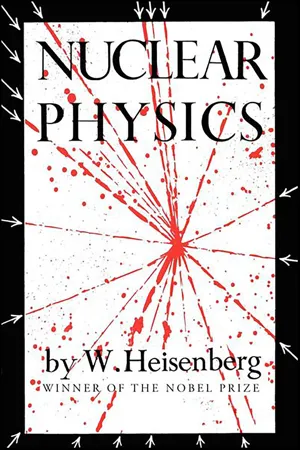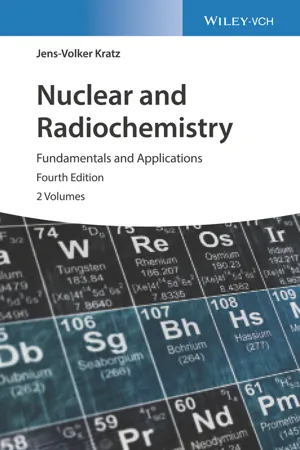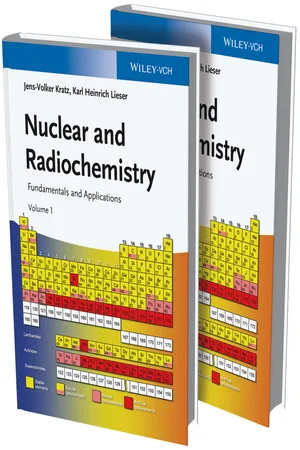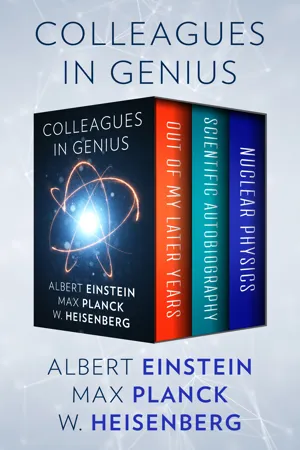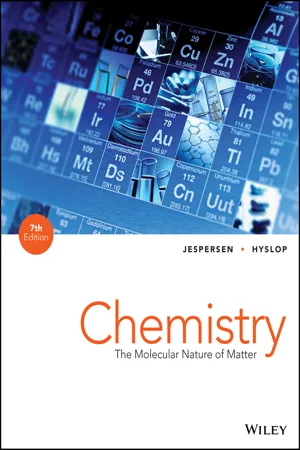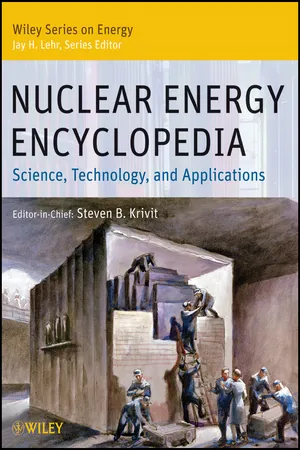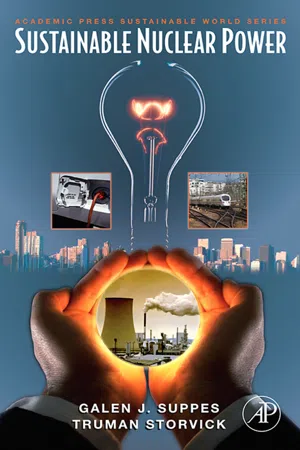Chemistry
Transmutation
Transmutation is the process of changing one element into another by altering the number of protons in the nucleus. This can be achieved through nuclear reactions such as radioactive decay, fusion, and fission. Transmutation has important applications in nuclear energy and medicine.
Written by Perlego with AI-assistance
Related key terms
Related key terms
1 of 4
Related key terms
1 of 3
9 Key excerpts on "Transmutation"
- eBook - ePub
- James E. Martin(Author)
- 2013(Publication Date)
- Wiley-VCH(Publisher)
3Radioactive Transformation
“Don’t call it Transmutation…they’ll have our heads off as alchemists.” Ernest Rutherford (1902)Much of what has been learned about atomic and nuclear physics is based on this remarkable property by which certain nuclei transform themselves spontaneously from one value of Z and N to another. Discovery of the emissions of alpha and beta particles established that atoms are not indivisible, but are made up of more fundamental particles. Use of the emitted particles as projectiles to transform nuclei led eventually to some of the greatest discoveries in physics.The process of radioactive transformation was recognized by Rutherford as Transmutation of one element to another. It is also quite common to use the term radioactive decay, but transformation is a more accurate description of what actually happens; decay suggests a process of disappearance when what actually happens is an atom with excess energy transforms itself to another atom that is either stable or one with more favorable conditions to proceed on to stability.3.1Processes of Radioactive Transformation
Atoms undergo radioactive transformation because constituents in the nucleus are not arrayed in the lowest potential energy states possible; therefore, a rearrangement of the nucleus occurs in such a way that this excess energy is emitted and the nucleus is transformed to an atom of a new element. The transformation of a nucleus may involve the emission of alpha particles, negatrons, positrons, electromagnetic radiation in the form of x-rays or gamma rays, and, to a lesser extent, neutrons, protons, and fission fragments. Such transformations are spontaneous, and the Q-values are positive; if the array of nuclear constituents is in the lowest potential energy states possible, the transformation yields a stable atom; if not, another transformation must occur. - eBook - ePub
- W. Heisenberg(Author)
- 2019(Publication Date)
- Philosophical Library/Open Road(Publisher)
6. THE NUCLEAR REACTIONSI. ALPHA RADIATIONMuch has been said in the preceding lectures about the changes of atomic nuclei. In such changes, one chemical element turns into another, and in this respect modern nuclear physics has realized, to a certain extent, the hopes which inspired the alchemists of past ages. Let us now consider these nuclear Transmutations more closely. The following two questions arise here: What elements can be changed into each other? Under what conditions is such a Transmutation at all possible? In order to answer these questions, we will classify the Transmutation processes into two groups: Firstly, the reactions which occur spontaneously, and secondly, those produced by external agencies.The spontaneous change of an element is called radioactivity, for the process is accompanied by an emission of radiation. The radioactive elements can be further subdivided into two classes: Firstly, those which emit alpha radiation, and secondly, those which emit beta radiation (either electrons or positrons). Gamma radiation may occur simultaneously, too. In addition to these, there are a few other processes, which will be discussed later.We shall begin with those Transmutation processes in which alpha rays are emitted. Alpha radiation consists of helium nuclei, each composed of two neutrons and two protons. We have already discussed when an emission of alpha radiation may be expected to occur. Approximately, from the element zinc upwards, the binding energy per particle decreases with the increase of the number of particles, due to the increasing intensity of the electrostatic forces of repulsion, and consequently, from the point of view of energetics, the emission of an alpha particle by the heavier elements may be advantageous under certain circumstances. When this occurs, the energy and range of the alpha particle are determined by the difference in mass defect between the original nucleus and the nucleus which is the product of the process. Thus, all alpha particles which are the product of a specific decay process have the same range (Figure 3 - eBook - ePub
Nuclear and Radiochemistry
Fundamentals and Applications
- Jens-Volker Kratz(Author)
- 2021(Publication Date)
- Wiley-VCH(Publisher)
13 Chemical Effects of Nuclear Transmutations13.1 General Aspects
The chemical binding energies between atoms vary between about 40 and 400 kJ mol−1 , corresponding to about 0.4–4 eV (1 eV ≈ 96.5 kJ mol−1 ). The energies involved in nuclear reactions are on the order of several megaelectronvolts, and parts of these energies are transmitted to the atoms in the form of recoil and excitation energy. Therefore, chemical bonds are strongly affected by nuclear Transmutations. High kinetic energy of single atoms does not mean high temperature, because the temperature of a system is given by the mean kinetic energy of all the atoms or molecules, (for three degrees of freedom). However, deviating from the usual concept of temperature, the temperature equivalent of a single particle may be related to its kinetic energy by the equation(13.1)Because energies on the order of 1 eV−1 MeV are transmitted to the atoms by nuclear Transmutations, corresponding to temperature equivalents on the order of 104 –1010 K, these atoms are called “hot atoms” and their chemistry is called “hot‐atom chemistry,” or “recoil chemistry” if the recoil effects are considered.Chemical effects of nuclear Transmutations were first observed by L. Szilard and T.A. Chalmers in 1934 (Szilard and Chalmers 1934 ) when irradiating ethyl iodide with neutrons. They found several chemical species containing 128 I that are produced by the chemical effects of the nuclear reaction 127 I(n, γ)128 I. In the following years, the chemical effects of radioactive decay were observed in gaseous compounds, liquids, and solids. The chemical effects of nuclear reactions can be divided into primary effects taking place in the atom involved in the nuclear reaction, secondary effects in the molecules or other associations of atoms, and subsequent reactions. Primary and secondary effects are observed within about 10−11 - eBook - ePub
Nuclear and Radiochemistry
Fundamentals and Applications
- Jens-Volker Kratz, Karl Heinrich Lieser(Authors)
- 2013(Publication Date)
- Wiley-VCH(Publisher)
13 Chemical Effects of Nuclear Transmutations13.1 General Aspects
The chemical binding energies between atoms vary between about 40 and 400 kJ mol−1 , corresponding to about 0.4–4 eV (1 eV ≈ 96.5 kJ mol−1 ). The energies involved in nuclear reactions are on the order of several megaelectronvolts, and parts of these energies are transmitted to the atoms in the form of recoil and of excitation energy. Therefore, chemical bonds are strongly affected by nuclear Transmutations. High kinetic energy of single atoms does not mean high temperature, because the temperature of a system is given by the mean kinetic energy of all the atoms or molecules, (for three degrees of freedom). However, deviating from the usual concept of temperature, the temperature equivalent of a single particle may be related to its kinetic energy by the equation(13.1)Because energies on the order of 1 eV to 1 MeV are transmitted to the atoms by nuclear Transmutations, corresponding to temperature equivalents on the order of 104 to 1010 K, these atoms are called “hot atoms ” and their chemistry is called “hot-atom chemistry ,” or “recoil chemistry” if the recoil effects are considered.Chemical effects of nuclear Transmutations were first observed by L. Szilard and T.A. Chalmers in 1934 [1] when irradiating ethyl iodide with neutrons. They found several chemical species containing 128 I that are produced by the chemical effects of the nuclear reaction 127 I(n, γ)128 I. In following years, the chemical effects of radioactive decay were observed in gaseous compounds, liquids, and solids. The chemical effects of nuclear reactions can be divided into primary effects taking place in the atom involved in the nuclear reaction, secondary effects in the molecules or other associations of atoms, and subsequent reactions. Primary and secondary effects are observed within about 10−11 s after the nuclear reaction.Primary effects comprise recoil of the nucleus and excitation of the electron shell of the atom. The excitation may be due to recoil of the nucleus, change of atomic number Ζ - eBook - ePub
Colleagues in Genius
Out of My Later Years, Scientific Autobiography, and Nuclear Physics
- Albert Einstein, Max Planck, W. Heisenberg(Authors)
- 2019(Publication Date)
- Philosophical Library/Open Road(Publisher)
III. OTHER TYPES OF SPONTANEOUS NUCLEAR TransmutationAlpha and beta radiation are by far the most frequent types of radioactive Transmutation. However, there is also a third process, already mentioned in a cursory manner, which is more or less the converse process of electron emission. In cases where it is advantageous, from the point of view of energetics, for a proton in the nucleus to change into a neutron, this transformation can be accomplished in two different ways. We have already discussed one of them—the emission of a positron. However, the same result is attained when the nucleus absorbs one of its own planetary electrons, in which case the electron, naturally, vanishes (as an absorbed photon vanishes) since its charge offsets the charge of the proton and changes the latter into a neutron. This process is called electron capture. As in this process no charged particle is emitted, the process can only be observed, from outside, by the consequent x-ray emission, K-radiation, since the absorbed electron usually comes from the innermost electron shell, the K -shell. As this process reduces the nuclear charge (atomic number) by one unit, the number of remaining electrons (the original number of planetary electrons minus one) is sufficient for the newly formed atom. But the remaining planetary electrons must now re-group themselves; an electron originally occupying a position in shell farther from the nucleus falls into and occupies the place vacated by the captured electron. This produces the x-ray emission, which is the K -radiation characteristic of the element in question. At the same time, in order to conserve the angular momentum or spin value of the atom—since the captured electron had a spin value of 1/2 h—a neutrino is emitted.Such a process occurs, for instance, in the beryllium nucleus 4 Be7 , an artificially produced radioactive isotope of beryllium. Capturing a planetary electron, it changes into the lithium nucleus 3 Li7 - eBook - ePub
Chemistry
The Molecular Nature of Matter
- Neil D. Jespersen, Alison Hyslop(Authors)
- 2018(Publication Date)
- Wiley(Publisher)
compound nucleus , has excess energy that quickly becomes distributed among all of the nucleons, but the nucleus is nevertheless rendered somewhat unstable. To get rid of the excess energy, a compound nucleus generally ejects something (e.g., a neutron, proton, or electron) and often emits gamma radiation as well. This leaves a new nucleus of an isotope different from the original target, so a Transmutation has occurred overall.- Compound here refers only to the idea of combination, not to a chemical.
Ernest Rutherford observed the first example of artificial Transmutation. When he let alpha particles pass through a chamber containing nitrogen atoms, an entirely new radiation was generated, one much more penetrating than alpha radiation. It proved to be a stream of protons (Figure 20.11 ). Rutherford was able to show that the protons came from the decay of the compound nuclei of fluorine-18, produced when nitrogen-14 nuclei captured bombarding alpha particles:- The asterisk, *, symbolizes a high-energy nucleus—a compound nucleus.
Another example is the synthesis of alpha particles from lithium-7, in which protons are used as bombarding particles. The resulting compound nucleus, beryllium-8, splits into two alpha particles.+He 2 4alpha particle→N714nitrogen nucleus→F *918flourine( compound nucleus )+O817oxygen( a rare but stable isotope )p 1 1proton( high energy )+p 1 1proton→Li 3 7lithium→Be * 4 8beryllium2alpha particlesHe 2 4Figure 20.11 Transmutation of nitrogen into oxygen. When the nucleus of nitrogen-14 captures an alpha particle, it becomes a compound nucleus of fluorine-18. This then expels a proton and becomes the nucleus of oxygen-17.Modes of Decay
A given compound nucleus can be made in a variety of ways. Aluminum-27, for example, forms by any of the following routes:→He 2 4+Na 11 23Al * 13 27→p 1 1+Mg 12 26Al * 13 27→H 1 2+Mg 12 25Al * 13 27- H 1 2
- eBook - ePub
Nuclear Energy Encyclopedia
Science, Technology, and Applications
- Thomas B. Kingery, Jay H. Lehr, Thomas B. Kingery(Authors)
- 2011(Publication Date)
- Wiley(Publisher)
A deficiency of even one of the required elements hinders the growth of the entire biological object. According to Vysotskii, the phenomenon of occurrence of Transmutation of chemical elements and isotopes in biological systems is based upon the heuristic proposition that if some of the essential elements are not present in the environment (in this case, the nutrient medium), then, provided certain prerequisites are met, these elements will be synthesized through appropriate nuclear Transmutation reactions. Vysotskii has arrived at such a proposition following more than a decade of experimental investigation of the topic of biological Transmutations. His new book [58], presents a detailed exposition of his experimental findings and theoretical conjectures. Needless to emphasize, Vysotskii's works are of great relevance to the urgent task of dealing with the problem of radioactive waste generated by nuclear power stations. His microbial Transmutation technique appears to have great promise and deserves study and replication. 43.14 Summary and Conclusions A brief summary of the major experimental investigations and results in the LENR field pertaining to the occurrence of a gamut of nuclear Transmutation reactions in simple experimental configurations has been presented. There are, in fact, many more such studies that could not be covered in this chapter due to space constraints - eBook - ePub
- Galen J. Suppes, Truman Storvick(Authors)
- 2006(Publication Date)
- Academic Press(Publisher)
CHAPTER 10Atomic Processes
Publisher Summary
This chapter focuses on atomic nature and its processes. Atoms consist of three basic subatomic particles: proton, neutron, and electron. The huge quantities of energy liberated in nuclear power plants originate from the nuclei of atoms. Nuclear Fission is a nuclear reaction that splits the atom, forming two new atoms each with about half of the original mass. There is the emission of a great quantity of energy; the mass loss is converted to energy by the Einstein equation. The natural stability of atoms is characterized by their half-lives. This chapter also gives information on stable nuclides and unstable nuclides, neutron to proton ratios, energy levels of atoms and nucleus, stability of nuclei and natural radioactivity. A highly unstable nucleus has a short half-life, while stable molecules have long half-lives. Transmutation transforms one atom into another by changing its nuclear structure accomplished by bombarding the atoms of interest with neutrons either in an accelerator or a nuclear reactor. Many countries are considering ADSs as a viable approach to Transmutation because these systems may be capable of destroying long-lived radioactive isotopes of all types without making plutonium. When two nuclei fuse with release of a large quantity of energy, nuclear fusion occurs. Radiation is the energy released as particles during radioactive decay whereas radioactivity is property of an atom that describes spontaneous changes in its nucleus. This chapter also explains biological effects of different types of radioactive and radiation exposures and calculation of mass defect and binding energy.Energies of Nuclear Processes
The huge quantities of energy liberated in nuclear power plants originate from the nuclei of atoms. In the fission process, relatively stable nuclei are induced into excited states that release energy as they form new stable nuclei. The heat produced in the nuclear reactor is converted to work through a heat engine power cycle. (See box for summary of terms used in this chapter.) - Mark Kernion, Joseph A. Mascetta(Authors)
- 2022(Publication Date)
- Barrons Educational Services(Publisher)
Notice how the addition of the mass numbers adds to 60 on both sides of the equation. Similarly, the atomic numbers on both sides of the equation total 27.The following uranium-radium decay series shows how a radioactive atom may change when it loses each kind of particle. Note that an atomic number is shown by a subscript (92 U) and the isotopic mass by a superscript (238 U). The alpha particle is represented by the Greek symbol α and the beta particle by β:The changes that occur in radioactive reactions and the subatomic particles involved are summarized in Tables 2.2 and 2.3 .TABLE 2.2 Radioactive Decay and Nuclear Change TABLE 2.3 Nuclear Symbols for Subatomic ParticlesParticle Symbols Nuclear Symbols Proton p Neutron n Electron e– or β–Positron e+ or β+Alpha particle α Beta particle β or β–Gamma ray γ Nuclear Reactions
Nuclear fission reactions have been in use since the 1940s. The first atomic bombs used in 1945 were nuclear fission bombs. Since that time, many countries, including our own, have put nuclear fission power plants into use to provide a new energy source for electrical energy. Basically, a nuclear fission reaction is the splitting of a heavy nucleus into two or more lighter nuclei.EXAMPLEU-235 is bombarded with slow neutrons to produce Ba-139, Kr-94, or other isotopes and also three fast-moving neutrons:A nuclear chain reaction is a reaction in which an initial step, such as the reaction above, leads to a succession of repeating steps that continues indefinitely. Nuclear chain reactions are used in nuclear reactors and nuclear bombs.A nuclear fusion
Index pages curate the most relevant extracts from our library of academic textbooks. They’ve been created using an in-house natural language model (NLM), each adding context and meaning to key research topics.
Explore more topic indexes
Explore more topic indexes
1 of 6
Explore more topic indexes
1 of 4

